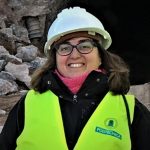I still remember when I first entered the Faculty of Geology. They called us the “Jurassic Park Generation”. Indeed, I was one of many who had fallen at the feet of Spielberg, his tyrannosaurs and his mosquitoes preserved in amber. Thus, thinking that I would be an intrepid paleontologist in search of the missing links of the most exotic species, I began my journey in the world of Geology.
Already in university, I went deeper into paleontology and I was able to participate in various excavations in Spain and France. It was then when I realized that I was not interested so much in those strange creatures who lived so many millions of years ago. I preferred to know more about why their skeletons could have been preserved forming fossils. What type of minerals were those that offered us any pieces of the great puzzle that makes up our origin and life? What mineral transformations had to take place so that we, today, could find an almost perfect reproduction of the anatomy of a creature that inhabited the Earth in the past? And so, I knew, my future was in mineralogy and petrology.
By chance, the end of my studies coincided with the boom in civil engineering in Spain and, specifically, in Madrid. Kilometers of tunnels were dug to improve the infrastructure of a city that was rapidly getting bigger and modernizing. Back then, while many of my petrologist and mineralogist colleagues were interested in fields such as oil or underground mining industry, I looked around and I wondered where the material needed to build those tunnels and buildings came from. What would be the useful life of these works of such magnitude?
Perhaps due to my youth, I put aside my investigative curiosity to take advantage of the wide offer of work that was then available to me. Thus, I could discover the operation of the private company. However, I was very curious and I tried to answer questions that came to me about civil engineering and construction materials. I learned a great deal about the exploration, exploitation, quality and durability of construction materials and the needs of small businesses and society around these materials. However, I missed Geology and having time to think about why some materials behaved in one way and others in another, or why some materials were deteriorated so easily while others endured in time and in our history.
With many questions stemming from my experience and always keeping in mind the needs of a continuously evolving society, I decided to embark on the hardest and most exciting journey in my life, my PhD. How to use my geological knowledge to construction materials and civil works? How to find the balance between why and for what of geological phenomena? I was able to develop some answers for these questions thanks to my experience in the Geotechnical Laboratory of the Center for Studies and Experimentation of Public Works (CEDEX) and the Laboratory of Petrophysics of the Institute of Geosciences (CSIC-UCM). There, thanks to a Spanish research grant that I obtained through the Ministry of Public Works, I worked closely with Geologists and Civil Engineers, with whom I was able to assess the deterioration suffered by the materials that make up the surface courses of Spanish roads when they are exposed to winter maintenance activities.
I knew better the mechanisms that deteriorated our roads due to the effect of winter and deicing salts. How could we reduce the use of these salts and, therefore, the degradation of our roads? With this question in mind and thanks to one scholarship, I traveled to Norway, where, again, I shared my knowledge and experience with Civil Engineers from the Norwegian University of Science and Technology (NTNU). There, we evaluated what type of rocks could be useful to generate surface courses with low adhesion to ice and, therefore, facilitate the removal of snow with snow plows.
Back in Spain, my concern led me to collaborate in a project related to sustainable solutions for small mineral deposits, this time with Mining Engineers from the Polytechnic University of Madrid (UPM). This time, I used my knowledge of the aggregate mining industry and rock behavior to help better understand the behavior of a rock mass against blasting in quarries and small underground mines. This was a great experience that not only enriched my knowledge in rock mechanics, construction materials, and mining, but also allowed me to teach university classes, co-direct the work of undergraduate and master students, and participate in educational innovation activities.
In 2019, I have started my journey as Assistant Professor at the Civil Engineering School, in the Department of Construction Materials of the Polytechnic University of Madrid (UPM). Here, I hope I can continue to ask myself and try to resolve the questions that this new experience asks me. Of course, always applying my geological knowledge and without forgetting that science and, especially Geology, must be at the service of society. For this reason, I have started working in the field of concrete durability, where I will be able to value and develop my knowledge of construction materials.
About Ana Patricia Perez Fortes
PhD in Geology, now Assistant Professor at Universidad Poltécnica de Madrid (UPM), always looking for new ways to apply Geology to Construction Materials
- More Posts(1)


